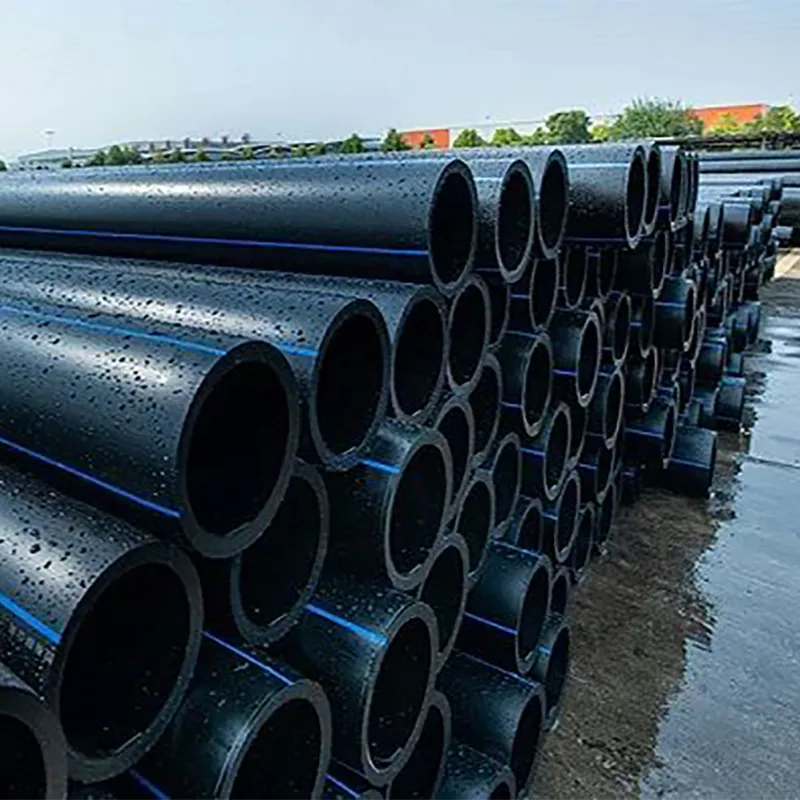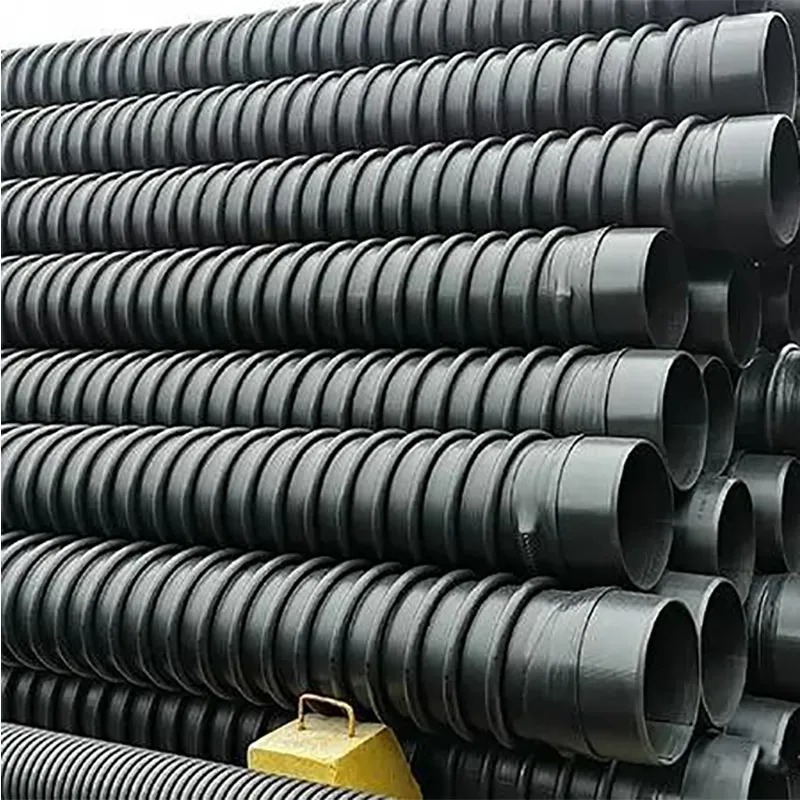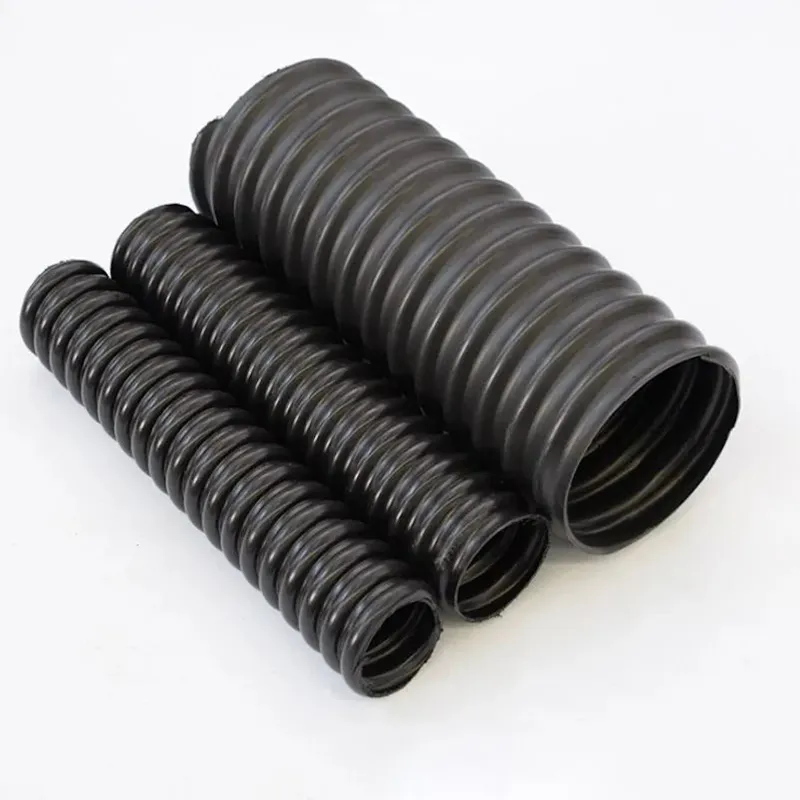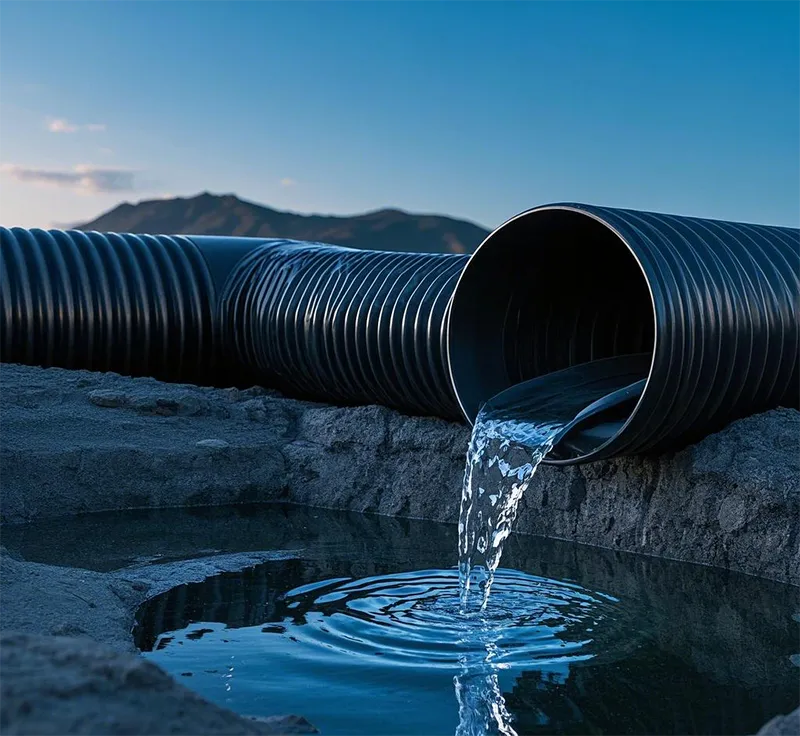Overview of indoor and outdoor pipes
Common pipe classification and characteristics
Ductile iron pipes, double-wall corrugated pipes, PSP steel-plastic composite pressure pipes, steel-plastic composite pipes, and PP-R plastic pipes are commonly used in domestic water supply system pipes;
Flexible cast iron pipes and UPVC plastic pipes, UPVC spiral silencer pipes, etc. are commonly used in drainage system (sewage and wastewater) pipes;
UPVC plastic pipes, UV-resistant plastic pipes, machine-made drainage cast iron pipes, etc. are commonly used in rainwater system pipes;
UPVC plastic pipes are commonly used in grey water pipes, ventilation risers, and condensate risers.
1. Rigid polyvinyl chloride (PVC-U) pipes
PVC-U pipes are made of sanitary polyvinyl chloride (PVC) resin as the main raw material, with appropriate amounts of stabilizers, lubricants, fillers, color enhancers, etc., extruded by plastic extruders and injection molded by injection molding machines, and completed through cooling, curing, shaping, inspection, packaging and other processes to produce pipes and fittings.
Advantages of PVC-U pipes: light weight, corrosion resistance, low water flow resistance, energy saving, quick installation, low cost.
Application scope: urban tap water supply and water supply projects, building internal and external water supply projects, industrial and mining enterprise water supply projects, underground fire protection water supply projects, farmland water conservancy water supply and irrigation projects, garden and horticulture greening water supply projects, aquaculture water supply and drainage projects, etc.
2. Random copolymer polypropylene (PP-R) water supply pipe
PP-R pipe is also called type III polypropylene pipe. It uses random copolymer polypropylene to be extruded into pipes and injection molded into pipe fittings. It is a new type of plastic pipe product developed and applied in Europe in the early 1990s. PP-R is a new generation of pipe materials in the late 1980s, using gas phase copolymerization technology to make about 5% PE randomly and uniformly polymerized (random copolymerization) in the molecular chain of PP. It has good impact resistance and long-term creep performance.
Advantages of PPR pipes: moderate price, stable performance, heat-resistant and heat-insulating, corrosion-resistant, smooth inner wall without scaling, safe and reliable pipeline system, impermeable, and service life of up to 50 years. It is said to never scale, never rust, never leak, and is a green and advanced water supply material.
Disadvantages of PPR pipes: high construction technology requirements, special tools and professionals are required for construction to ensure system safety.
Application areas of PPR pipes:
(1) Hot and cold water systems of buildings, including central heating systems;
(2) Heating systems in buildings, including floors, wall panels and radiant heating systems;
(3) Pure water supply systems that can be directly drunk;
(4) Central (central) air-conditioning systems;
(5) Industrial pipeline systems for transporting or discharging chemical media.
3. Aluminum-plastic composite water supply pipes
Aluminum-plastic composite pipes are the earliest water supply pipes to replace cast iron pipes. Their basic composition should be five layers, namely plastic, hot melt adhesive, aluminum alloy, hot melt adhesive, and plastic from the inside to the outside.
Aluminum-plastic composite pipes have good thermal insulation performance, and the inner and outer walls are not easy to corrode. Because the inner wall is smooth, the fluid resistance is very small; and because it can be bent at will, it is easy to install and construct.
There are three main types of aluminum-plastic water supply pipes on the market:
(1) PE/AL/PE;
(2) PE/AL/PEX;
(3) PEX/AL/PEX.
The first type is that the inner and outer layers are polyethylene, the second type is that the inner layer is cross-linked polyethylene and the outer layer is polyethylene, and the third type is that both the inner and outer layers are cross-linked polyethylene, and the middle layer is aluminum. The first type is generally used for cold water pipe systems, and the latter two are generally used for hot water pipes.
4. Copper pipe
Also known as red copper pipe. A type of non-ferrous metal pipe, it is a pressed and drawn seamless pipe.
Advantages: Copper pipes are hard, not easy to corrode, and resistant to high temperature and high pressure. They are the best water supply pipes.
Disadvantages: High price.
5. Thin-walled stainless steel pipe
The wall thickness is 0.6~2.0mm, and the stainless steel strip or stainless steel plate is made of fusion welding process such as automatic argon arc welding.
The domestic thin-walled stainless steel water pipe is a new type of pipe that came out in the late 1990s. Due to its safety and hygiene, high strength, good corrosion resistance, durability, long life, maintenance-free, and beautiful appearance, the current stainless steel water pipe has a strong development momentum and has been widely used in building water supply and direct drinking water pipelines.
Thin-walled stainless steel pipes (Light gauge stainless pipes) have the following outstanding advantages: excellent mechanical properties, superior wear resistance, good safety and hygiene performance, good temperature resistance, good thermal insulation performance, smooth inner wall and small water resistance; beautiful, clean and fashionable appearance, 100% recyclable and reusable; conducive to saving water resources; wide range of use; long service life and low comprehensive cost.
6. Hot-dip galvanized steel pipe
Galvanized steel pipes are divided into cold-dip galvanized pipes and hot-dip galvanized pipes, and the former has been banned. Hot-dip galvanizing pipes are made by reacting molten metal with the iron matrix to produce an alloy layer, thereby combining the matrix and the coating. Hot-dip galvanizing is to pickle the steel pipe first. In order to remove the iron oxide on the surface of the steel pipe, after pickling, it is cleaned in an ammonium chloride or zinc chloride aqueous solution or a mixed aqueous solution of ammonium chloride and zinc chloride, and then sent to the hot-dip coating tank. Hot-dip galvanizing has the advantages of uniform coating, strong adhesion and long service life. The hot-dip galvanized steel pipe matrix undergoes complex physical and chemical reactions with the molten plating solution to form a corrosion-resistant zinc-iron alloy layer with a tight structure. The alloy layer is integrated with the pure zinc layer and the steel pipe matrix. Therefore, it has strong corrosion resistance.
7. Welded steel pipes
It can be divided into straight seam welded pipes and spiral welded pipes. It can be used in fire water supply pipe networks. It has the advantages of high strength and strong strain resistance, but its corrosion resistance is poor and should be treated with corrosion protection. Steel pipes of the same diameter have different thicknesses, so the wall thickness should be indicated when selecting.
Straight seam welded pipe: simple production process, high production efficiency, low cost, and rapid development.
Spiral welded pipe: generally higher strength than straight seam welded pipe, can use narrower billets to produce larger diameter welded pipes, and can also use the same width of billets to produce welded pipes of different diameters. However, compared with straight seam pipes of the same length, the weld length increases by 30~100%, and the production speed is lower. Therefore, smaller diameter welded pipes are mostly straight seam welded, while large diameter welded pipes are mostly spiral welded.
8. Chlorinated polyvinyl chloride (PVC-C) water supply pipe
PVC-C resin is the masterbatch, and auxiliary materials such as impact resistance agent and stabilizer are added and extruded at high speed.
Its characteristics:
(1) Strong: Since PVC-C is stronger than PP-R, PB and PEX, fewer hooks and brackets are required. PVC-C can withstand greater pressure. At the same flow rate, PVC-C pipes can use smaller diameters compared with PP-R, PB and PEX pipes.
(2) Easy installation: It can be connected using a special welding agent. No special tools are required during installation. It is suitable for both open and concealed installation.
(3) Corrosion resistance: PVC-C is not easy to penetrate oxygen, so the metal parts in the system will not corrode due to oxidation.
(4) Good flame retardancy: The oxygen index of PVC-C is 60, and its combustion capacity is very low. It will extinguish immediately when away from the fire, and will not produce fire droplets. It can also suppress the generation of smoke and toxic gases.
(5) Not affected by residual chlorine: Unlike polyolefin pipes, PVC-C pipes will not be affected by residual chlorine in water after long-term use, and will not crack or leak.
(6) Acid and alkali resistance: PVC-C has strong corrosion resistance to both acids and alkalis, and can be used to transport HCL and NaOH liquids.
(7) Bacteria are not easy to reproduce: Many tests have confirmed that bacteria are not easy to reproduce in PVC-C pipes. The bacterial growth rate is 1/60 of PEX pipes, 1/10 of copper pipes, and 1/4 of steel pipes. The number of Legionella in the water sample is 1/13 of that of PEX pipe and 1/17 of that of PP-R pipe.
(8) Low thermal expansion coefficient and aging resistance: Compared with other plastic pipes, the thermal expansion coefficient of PVC-C pipe is relatively small, about 1/2 of that of other plastic pipes such as PP-R, PB and PEX. PVC-C pipe has strong UV resistance and can be used outdoors, while general polyolefin pipes cannot.
(9) Superior hygienic performance standards: PVC-C hot and cold water pipes have been tested by many international water quality and sanitation authorities, and the results are better than the standards for drinking water of the World Health Organization and the Ministry of Health of the People's Republic of China.
9. Polyethylene (PE) pipe
No heavy metal salt stabilizer is added during the processing of PE pipe. The material is non-toxic, has no scaling layer, and does not breed bacteria, which effectively solves the secondary pollution of urban drinking water. Except for a few strong oxidants, it can resist the erosion of various chemical media; there is no electrochemical corrosion. Under rated temperature and pressure conditions, PE pipes can be safely used for more than 50 years. PE pipe has good toughness and high impact resistance. Heavy objects can directly press over the pipe without causing the pipe to rupture. The strength of the hot-melt or electric-melt joint of PE pipe is higher than that of the pipe body, and the joint will not be disconnected due to soil movement or live load. The pipe is light, the welding process is simple, the construction is convenient, and the overall cost of the project is low.
10. Acrylonitrile-butadiene-styrene (ABS) engineering plastic water supply pipe
The material for making the pipe is a mixture of acrylonitrile-butadiene-styrene, of which ABS resin is the main component. Only additives required to improve its physical, mechanical properties and processing properties are added. The additives should be evenly dispersed. The density of acrylonitrile-butadiene-styrene (kg/m3) is: 1000≤ρ≤l070. The acrylonitrile in the raw material of acrylonitrile-butadiene-styrene should be greater than 20 (mass fraction), and the other components should not exceed 5% (mass fraction). The raw materials should be made into pipes and tested according to GB/T 18252. The minimum required strength MRS≥14 MPa and the minimum value of the overall use (design) coefficient C is 1.6.
The production of ABS pipes and fittings shall comply with the provisions of GB/T 20207. Chlorinated polyvinyl chloride pipe systems used to transport drinking water shall comply with the requirements of GB/T 17219-1998.
According to the chemical resistance and sanitation of the material, it is suitable for the transportation of fluids such as powders, liquids and gases in industries such as pressure water supply and drainage, sewage treatment and water treatment, petroleum, chemical industry, power electronics, metallurgy, mining, electroplating, papermaking, food and beverage, air conditioning, medicine, and construction.
11. Plastic-coated steel pipe
Steel-plastic composite pipe, the product is based on seamless steel pipe and welded steel pipe, and the inner wall is coated with high adhesion, anti-corrosion, food-grade hygienic polyethylene powder coating or epoxy resin coating. The diameter range is DN15--DN1200, which can be coated with flanges and pressure grooves. Length 6m, 9m, 12m and indefinite length Coating wall thickness is between 100 microns and 500 microns, usually 350 microns.
Product features:
(1) Sanitary and non-toxic, no scale accumulation, no breeding of microorganisms, and guaranteed fluid quality.
(2) Resistant to chemical corrosion, soil and marine biological corrosion, and cathode stripping.
(3) The installation process is mature, convenient and fast, and the connection is similar to that of ordinary galvanized pipes.
(4) Good weather resistance, suitable for harsh environments such as deserts and saline-alkali.
(5) The pipe wall is smooth, improves transportation efficiency, and has a long service life. Common steel-plastic composite pipes include: steel-lined polypropylene composite pipe (GSF.PP), steel-lined polyvinyl chloride composite pipe (GSF.PVC), steel-lined polyethylene composite pipe (GSF.PE), and steel-lined polytetrafluoroethylene composite pipe (GSF.F4).
12. Plastic-lined steel pipe
It can be divided into straight seam welded pipe and spiral welded pipe. It can be used in fire water supply pipe network. It has the advantages of high strength and strong strain resistance, but its corrosion resistance is poor and should be treated with anti-corrosion. Steel pipes of the same diameter have different thicknesses, so the wall thickness should be indicated when selecting.
Straight seam welded pipe: simple production process, high production efficiency, low cost, and rapid development.
Spiral welded pipe: The strength is generally higher than that of straight seam welded pipe. It can produce welded pipes with larger diameters with narrower billets, and can also produce welded pipes with different diameters with billets of the same width. However, compared with straight seam pipes of the same length, the weld length increases by 30~100%, and the production speed is lower. Therefore, smaller diameter welded pipes are mostly straight seam welded, while large diameter welded pipes are mostly spiral welded.
13. Cast iron pipe
Ductile iron pipe is a type of cast iron pipe used as a water supply pipe for underground laying.
Its advantages are that it is cheaper than steel pipes, easier to manufacture, and has strong corrosion resistance; its disadvantages are brittleness and heavy weight.
There are data showing pipes between DN40 and DN80, but the design manual only lists specifications above DN80. There is no change in pipe wall thickness due to nominal pressure, and there is no need to specify the nominal pressure level.
14. High-density polyethylene (HDPE) drainage pipe
HDPE is a highly crystalline, non-polar thermoplastic resin. The original HDPE has a milky white appearance and is translucent to a certain extent in a thin cross section. In the water supply and drainage pipeline system, plastic pipes have gradually replaced traditional pipes such as cast iron pipes and galvanized steel pipes and become the mainstream pipes. Compared with traditional pipes, plastic pipes have significant advantages such as light weight, corrosion resistance, low water flow resistance, energy saving, simple and quick installation, and low cost, and are favored by the pipeline engineering industry.
HDPE pipes are mainly used for: municipal engineering water supply systems, indoor water supply systems of buildings, outdoor buried water supply systems and buried water supply systems in residential areas and factory areas, repair of old pipelines, water treatment engineering pipeline systems, industrial water pipes for gardens, irrigation and other fields, etc.
15. Reinforced polypropylene (FRPP) molded pipes
Glass fiber reinforced polypropylene (FRPP) pipes are produced using glass fiber modified polypropylene raw materials treated with coupling agents. The product has the characteristics of corrosion resistance, high strength, anti-leakage, low internal resistance, tensile strength, bending resistance, low cost, long life, easy installation and maintenance, etc. It is widely used in petroleum, chemical, electric power, textile, metallurgy, pharmaceutical, papermaking, food, mining, garbage disposal, construction and other industries. It is used as corrosive liquid transportation and process pipelines and is deeply trusted by users.
16. Glass fiber reinforced plastic sand (RPM) pipe
The pipe is made of high-strength glass fiber reinforced plastic as the inner and outer reinforcement layers, and the middle is made of cheap quartz sand/resin as the core layer to improve the rigidity of the pipe. It is supplemented by a tough acid and alkali corrosion-resistant lining layer and an outer protective layer that meets the requirements of the working environment to form a composite pipe wall structure. RPM pipes can be produced by centrifugal casting or winding process. Therefore, there are two types of composite pipes: composite pipes, wound pipes, composite pipes and centrifugal casting pipes. When the centrifugal casting process is used, the glass fiber uses short fibers; when the winding process is used, the glass fiber uses long fibers. The maximum diameter of the centrifugally cast RPM pipe is 2400mm, and the maximum diameter of the fiber-wound RPM pipe can reach 4000mm. It is a thermosetting plastic pipe.
Its characteristics are:
(1) Good corrosion resistance;
(2) Lightweight and high strength;
(3) Easy to install;
(4) Smooth inner surface and high flow capacity;
(5) Good low temperature resistance;
(6) Good thermal insulation performance.






294.webp)
476.webp)
420.webp)
146.webp)
460.webp)
287.webp)
274.webp)
688.webp)


